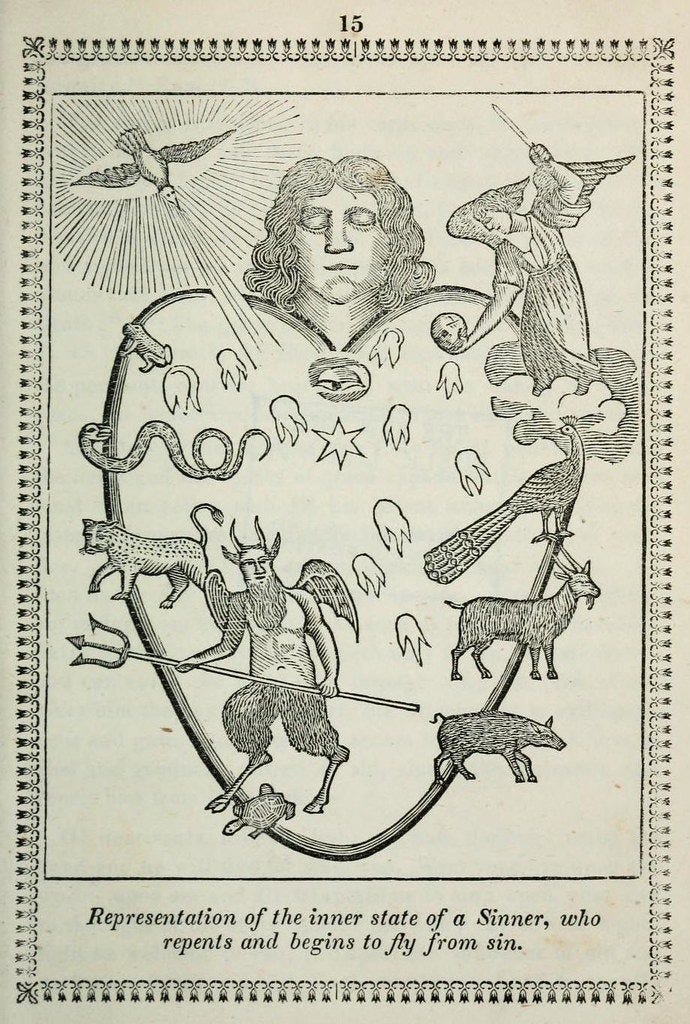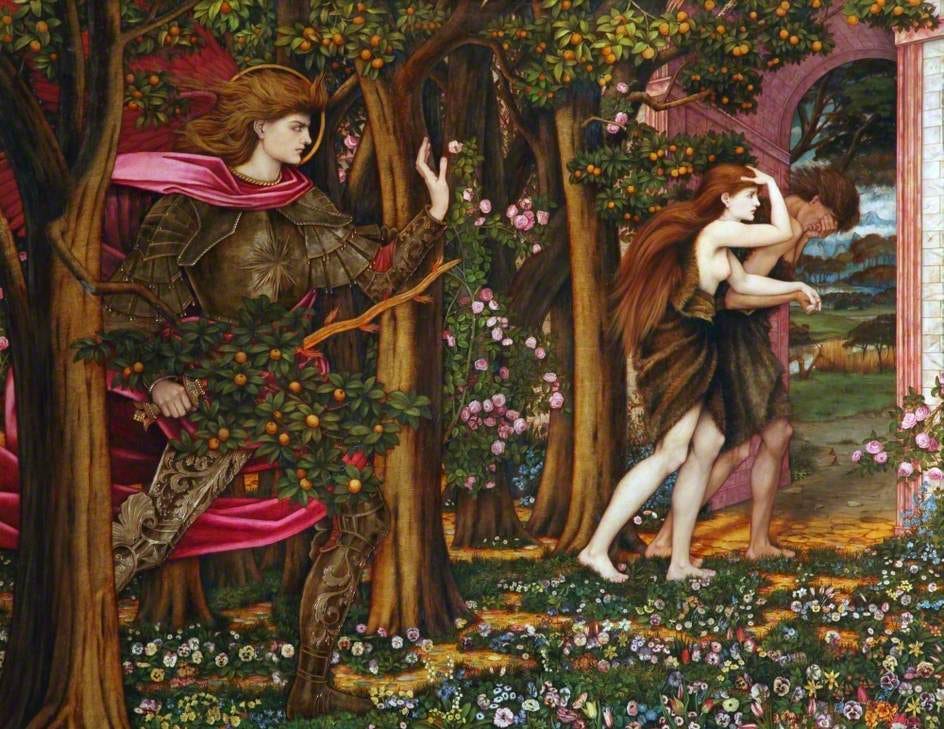Miscellany #8: Spring 2025
1.
Ekstasis published a poem by A. A. Kostas called “Urban Revival Project.” The poem addresses the often overlooked truth that the city—where human vice is most easily evident, and where the natural world is often difficult to see—is the place where humanity, whom “God so loved,” is primarily to be found. Kostas points out that it isn’t the institutions that matter in the city; what matters are the people, the image-bearers of God.
Aside from the poem’s thematic content I was intrigued by Kostas’ use of the repeated interrogation points that divide the verses. The effect is the same as a drone bass in a musical work; the idea of “question” thereby underpins the poem in a formally innovative and pleasing way.
2.
At Art and Theology, Victoria Emily Jones showcased a set of emblems from a nineteenth-century devotional book (which were originally published in a different devotional book from the late 1600s) illustrating the journey of a sinner away from sin and toward repentance and fellowship with Christ. Here is one of the images. This series of images is in quite a different visual style, and therefore has quite a different mood, than another series of emblems which Jones wrote about last fall.
Abstract concepts like “salvation,” “repentance,” and “communion” are rather hard to visualize coherently; there is often a surreal strangeness to some of the imagery in these emblem books. They are certainly very visually arresting, and they exemplify the concept of “weird Christian art” quite nicely.
3.
For Mockingbird, I wrote about boring instrumental parts in music, and how these bland and tedious parts are, in fact often essential to the musical whole; the analogy is that the boring, tedious, and unglamorous parts of our society (janitor, fry cook, hotel housekeeping services, etc.) are also of vital importance to the broader functioning of civilization.
4.
I wrote in World about Millais’ Christ in the House of His Parents. This painting was extremely controversial when it was first exhibited; critics hated its naturalness and attention to detail, claiming that Millais had not given the Holy Family appropriate idealization and gravitas. Amelia McKee also wrote about the same painting; here is the second part of her two-part essay, analyzing in depth the rich symbolism with which Millais filled his canvas.
5.
Here is a survey of some Baroque and Rococo pulpits. Some of these (mostly from central European Catholic churches and cathedrals) are mind-bogglingly intricate; very, very different from the austere pulpits of unpainted wood being built in New England at around the same time. What do the different styles of worship architecture say about the differences in worship itself between the various branches of Christianity?
6.
Sam Kahn shares a brain dump about art and ethics on his blog Castalia. This is a topic which seems sorely overlooked, especially in Christian circles. Here is a tricky ethical point, relevant to discussions of how artists use material from their personal relationships when they are making their art: how far should artists go in the direction away from tactfulness and towards transgressiveness? Is there a point at which the trust that is given to an artist is breached by that artist’s actions? As Kahn says: “The artistic zone creates a license, and we despise nobody so much as those who abuse the trust of that license. They are the serpents in the garden. Telling them apart from the genuine article is the work of the critic.”
7.
Speaking of ethics: W. David O. Taylor discusses violent imagery in movies, and asks if the filmmakers are somehow culpable for the violence that their films inspire. images. Once again, the ethics becomes tricky:
Is it the responsibility of filmmakers to guard against these kinds of violent responses? It all depends on what we mean by “guard against.” If it is true, as the critical theorist W.J.T. Mitchell suggests, that the life of images is not a private or individual affair but rather a “social life,” then perhaps we need to ask ourselves basic questions about the mutual relationship between artist and society. While such questions cannot be easily resolved, I believe our assumptions need to be continually interrogated.
8.
In Front Porch Republic, Carter Davis Johnson wrote about T. S. Eliot’s “Journey of the Magi.” This has always been one of my favorite poems, especially that haunting line at the end: “I should be glad of another death.” Johnson focuses his account on how Eliot manages to make the nativity story strange in a welcome way; this story, heard so often that it has the danger of becoming mundane and unremarkable, was actually the most shockingly weird thing to ever happen on earth, and Eliot highlights the weirdenss of it in his poem.
10.
Here is John Roddam Spencer Stanhope’s painting The Expulsion from Eden, featuring a large masonry gate at the exit to the garden of Eden. It occurs to me that there is nothing in the Biblical account which rules out the possibility that the garden may have been furnished with such things as walls, gates, pergolas, trellises, benches, etc. made by God himself. Could it be that these forms of architecture have been copied for millennia from memories of divine originals?
11.
Apropos of the Stanhope painting: Liv Ross’ poem “Fading Moon.” This poem imagines if Eve, watching the moon wane from full to a crescent, might have wondered if that, too, was a result of her sin in the garden.
12.
Gary Ball and Alex Sosler’s The Artistic Vision podcast features interviews with several thinkers and theorists in the Christianity / art space; I just came across it recently and I’m already astounded by the quality of thought evident in the speakers featured so far. Their talk with Taylor Worley would be worthwhile for anyone who wonders what to make of all the crazy performance art that has been a feature of the art world since the sixties, and how this kind of art can be appreciated from a theological perspective.
13.
Two valuable book series: Routledge’s Studies in Theology, Imagination, and the Arts and IVP’s Studies in Theology and the Arts. I’ve been slowly collecting the volumes from both of these sets, and have already found a wealth of important and thought-provoking scholarship within them.
Reading scholarly books and listening to podcasts and telling other people about them reminds me of how, in the Italian Renaissance, a network of scholars developed who would share manuscripts and puzzle over ideas together, resulting in further scholarship and the development of a robust network of intellectual inquiry: my greatest hope is that such a network can develop among Christians pursuing studies in the arts-and-theology field. Such a network is deliberately being cultivated by Ecstatic’s series of Inkwell events—is it too much to hope that one of these events will find its way to Omaha sometime?
14.
For Ecstatic, Samuel Christian writes about the way communities can foster creativity. He marshals a wide array of examples to illustrate his theses—from high-profile groups like the Inklings and the circle of painters who gathered around Georges Bazaille to the times when he himself would make films with his siblings or work on poetry with a friend. He looks fondly on the “sense of security that allows us to remain honest, open, and vulnerable with each other.” It can indeed be formidable for an artist to share their raw and honest creations with an indifferent and potentially hostile public; but within a community of fellow artists, the needed vulnerability can be realized.
The first creative team of all was, of course, the triune God on the first week of the world’s existence. This creative community is a model for how artists on earth can practice their own artistic pursuits, or as Samuel says:
The ultimate creative act was only possible through relationship. In the beginning, God created out of a place of trinitarian relationship. Father, Son and Spirit crafting as one a masterful work; life itself. My aunt says that it is a bit like a film. A director, actor, and writer, all simultaneously present in a scene. And God created people in his image, that he might have a relationship with them. To live out of this identity, the imago dei, this essence of who we are, is to represent the attributes of God, no matter how pale the imitation, within this world. Creativity is something we can practice because of this. And to create as God did, is to create out of relationship, for relationship.
15.
Omaha readers: the artist group at Coram Deo church will be showing some of their work in the church’s gallery. I will be there, giving away chapbooks of some of my poems, at the show’s opening reception on April 4th. If you can make it, I’d love to see you there!




William, thank you for including my poem, and for the connection to that wonderful painting! I will be staring at that one for a while.
Thanks William, honoured to be included. And lots of other interesting things to explore here!